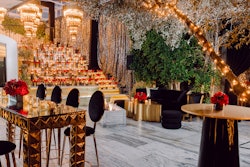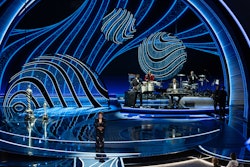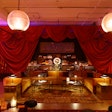
LOS ANGELES—For better or for worse, Sunday's 93rd Academy Awards looked drastically different this year. Instead of its typical jam-packed, crystal-filled gathering at Los Angeles's Dolby Theatre, the pandemic-safe ceremony moved to the historic Union Station, where the show's 170 attendees sat at small, socially distanced banquet tables.
Producers Steven Soderbergh, Jesse Collins and Stacey Sher took a number of steps to keep attendees safe. Only the nominees, their guests and the presenters were able to attend the show, and they were periodically cycled in and out of the main space and courtyard areas to maintain appropriate capacity restrictions. The traditional red carpet was dramatically downsized, and guests were required to wear face masks when not on camera. Attendees in Los Angeles had been tested and quarantined; those who couldn't travel gathered in London, Paris and other international hubs.
Despite all the changes, the three-hour broadcast featured no shortage of buzzy moments, like Nomadland director Chloé Zhao’s historic win, a rousing acceptance speech from Daniel Kaluuya and, of course, Glenn Close’s “Da Butt” dance—but ended with a surprise upset for the late actor Chadwick Boseman, who lost the Best Actor award to Anthony Hopkins.
Unsurprisingly, such an unconventional ceremony drew some mixed reactions from event producers. BizBash chatted with seven of them to get their thoughts on the event.
Matt Stoelt
Letter Grade: B+
"Intimate, authentic and genuine, the 93rd Academy Awards were a throwback to its original roots and format, hosted at the historic and iconic Union Station in Downtown Los Angeles. Scoring a significant step forward for events and mass gatherings, a predominantly maskless and socially distanced audience was seated in custom banquets donning the Oscar statue silhouette on the lampshades and what appeared to be speakers on the table to meet the challenges of the acoustics of the room.
This classic 1940s setting, styled with an art-deco vibe, featured an elaborate, static drapery backdrop, a small round stage with wood inlays, and curved ironwork that supported different shaped LED screens, a modern twist on a classic look.
The technical production was flawless; however, the producers battled the natural light flooding the room early in the show, making it difficult for the cameras to hold focus. As day turned to night, the room took on a more defined and classic look.
Unlike years past, presenters were situated among audience members versus being on the stage, giving the program a much more relaxed and informal feel. Also different this year was the music direction by Questlove, giving the program an upbeat vibe and a departure from the traditional symphonic and broadway narrative.
Overall, I feel like the producers did a great job of merging the show's core elements with the fundamentals of its purpose.”
Matt Stoelt is the CEO and creative director of Stoelt Productions, an event, marketing and creative firm with offices in Los Angeles, New York and Miami, and clients like Jason Wu, Resy, Lyft and Billboard.
Allison Pieter
Letter Grade: A
“The 2021 Oscars presented a ginormous challenge: how to produce the world’s biggest awards show during a worldwide pandemic in a way that felt both celebratory and authentic to the times. Overall, the producers did a phenomenal job and should be congratulated.
While some questioned the move to Union Station, it worked well on multiple levels. There was plenty of outdoor space to create and safely execute pre- and post-event broadcasts, in addition to providing ample seating for the attendees. Inside, the openness of the iconic terminal provided a wonderful foundation for the main event. Had the show remained at the Dolby Theatre, the empty seats required for social distancing would have been a constant reminder of whom and what was missing. At Union Station, the producers created an intimate setting that allowed the celebration of movies to be front and center.
The production design also met the moment by scaling down to move forward. This year, instead of the tens of thousands of crystals or flowers typically used, the simplified stage felt celebratory without being tone-deaf. The rich, vibrant colors seen in the stage backdrop and the graphic on-screen treatments were complemented by pops of metallics showcased around the room in the beautiful art-deco setup. The table design was a tad oversimplified; the LED side lights may have benefited from a branded wrap treatment. The outside area was a breath of fresh air. With the natural deck built around the existing trees, and topped with beautiful floral highlights, the designers created a refreshing space without being over the top.
The production was tightly run and well-rehearsed, and it showed. The presenters kept the show moving along, and the program did not suffer for lack of a host. The factoids about each nominee helped connect us to each other, although some ran a bit long. I loved the inclusion of the nominees from around the world, and by requiring them to attend in a controlled location, the quality was consistent across the board, something lacking in previous award shows. The preproduced performances for Best Song nominees introduced us to the Academy Museum, creating buzz for its fall opening.
Overall, the producers and their team created a solid, well-paced, beautifully designed celebration of movies in the middle of a worldwide pandemic while keeping attendees and crew safe—no easy feat.”
Allison Pieter is the founder and president of Cassis Productions in Los Angeles, and she has produced events for Hulu, Freeform, Universal Pictures, Dreamworks and iHeartMedia.
Christy Bareijsza
Letter Grade: C+
“Making the decision to not follow the pandemic virtual award show trend, I applaud the 93rd annual Oscars for being an advocate in forging the challenging path back to event normality. The Oscars' creative team boasted precedence of combining old Hollywood glamour with casual seating and a cinematic format—but unfortunately, the concept did not translate effectively to the general viewer.
Having planned events in historical landmarks, I understand the production challenges faced in maintaining Union Station as a secure and contamination-free location, along with navigating through arduous venue guidelines—but I perceived the theme to lack the glorification needed to properly enhance the breathtaking venue. Known as “the last of the great train stations,” there was a lack of architectural highlighting to the newly renovated space or homage to the art Deco genre and formal attire requirement. The pastel and floral themed outdoor seating area could have appeared more vintage with the use of rich tones, stylized pieces and lush fabrics, assimilating the ever-changing seating arrangements with a transportation theme, a more elaborate stage set and integration of full video projection, verses multiple small plasma screens, on which the content often did not coincide with the category announcements.
There was also disconcertion by the use of natural light illuminating through the station windows, which seemed to improperly off-set the stage lighting, washing-out the earlier presenters on camera prior to sunset. Viewers also witnessed a great deal of attendee concern, rather than celebratory emotions, when migrating to and from each location, assuming due to safety caution or basic confusion.
The option to not use a host, with the intention to treat the ceremony format like a film, would have been ideal if the concept was produced more efficiently. The content was often lost in translation and ultimately perpetuated a slow-moving and disconnected show. The main cause for confusion seemed to lie with the presenters’ lack of keeping on topic, supported by poor nominee announcement transitions. There were multiple spotlight and camera slips, often catching guests in awkward acts due to the presenters standing within the cabaret tables, rather than on the stage, which led to even more disorientation with the winner's acceptance redirecting to the stage. Unfortunately, the entire show seemed unnecessarily complicated for the sake of trying to be at the forefront of innovation, which fell flat for viewers.
Regardless, the creative team's valiant production efforts were commendable, especially in a world where the pandemic has viciously decimated the event industry. For almost a century, the Oscars have successfully maintained the gold standard in award ceremonies and have once again fearlessly succeeded in being leaders in industry recovery, to which they deserve immeasurable gratitude.”
Christy Bareijsza is the founder and chief experience officer for Events By Red Carpet, where she’s produced experiences for clients like Mashable, Jack Daniel’s, IMG, Alzheimer’s Association and A&E Networks.
Alexandra Rembac
Letter Grade: B
“While Oscars ratings have been spiraling downward for years, I’m always optimistic that a new year could spark enough change to bring it back. After a year like 2020, revitalizing the Oscars pandemic-style is definitely no easy feat. I loved the idea of shifting to Union Station; it’s truly one of our hidden gems and has some of the most exquisite architecture in Los Angeles. ... What a time to go back and bring some Hollywood glitz and glamour to this iconic location. I commend the entire Rockwell team for the move and taking the risk to do in a time like now and execute such a unique design. Designing in a public venue will always add loads of logistics and elements—some you can prepare for and some not.
I thought overall, from what we saw, the transition for the times was executed beautifully. I loved the use of all the ancillary space on the patios and around, and I especially loved Regina King’s cinematic entrance. That power strut as she navigated us through the exterior and right up to the stage definitely set the tone that things would be different for this show, and I felt it was engaging and, of course, different than a typical opening number.
The main concourse design looked incredible. From the moment they showed viewers the room, I was really captivated with the stairs, layers and overall aesthetic. I appreciated so many of the details, from the texture to the color combinations to even the flowerless tables leaving the lush pops in large sequence only. It felt like an Old Hollywood social club, and the individual lamps with the laser-cut Oscars were such a nice touch. Although, I was underwhelmed by the stage—I felt for how deliberately the rest of the space was designed, more should have been done here.
While a no-host format isn’t necessarily my favorite for a show, I felt it was also appropriate to the time and ultimately the right move. Often filled with comedic bits, I think that could have appeared a little tone-deaf, and the way it was produced felt more purposeful and generated more connection. There were quite a few moments from the storytelling of a nominee’s journey to the humanitarian awards to Youn Yuh-jung's wittily charming acceptance speech to Glenn Close doing 'Da Butt' that allowed different viewers to connect. The show was and felt very intimate, very purposeful, and at the same time, even a tiny bit organic in some moments. I did wish more could have been said and felt during the 'In Memoriam'—it not only felt too fast but also just not entirely appropriate for the time. In speaking to that and a few other moments, I think the flow of the night was in fact unexpected, but I also tend to celebrate taking creative risks. Yet I didn’t love Best Picture moving up and the Best Actor categories closing out the show. The conclusion of the evening did in fact feel a bit abrupt.
Of course, what you see as a viewer is only the smallest slice of a pie that’s filled with so many ingredients and taken such precision to bake. The protocols for a show of this size at a location like Union Station with a production team like they had is somewhat of a show in itself. I actually appreciate that the opening called out, even in a single statement, the how and why they weren’t in masks and what would happen in between, etcetera. I think it showed the reality of what we are in, that protocols were, in fact, being taken seriously—as most people don’t know how meticulous Appendix J is and what it’s like for productions to get the job done right now. I think they achieved a very difficult task and did so successfully while still under such challenging guidelines."
Alexandra Rembac is the founder and creative director of Los Angeles-based Sterling Engagements, where she's been producing corporate and social events for high-profile clients since 2005.
Molly Nelson
Letter Grade: B+
“The Oscars faced an uphill battle for their 93rd ceremony with the lasting effects of a global pandemic. They, of course, had to physically gather in a safe and socially distanced way, and find a way to maintain the relevancy of certain nominees that were released as far back as September 2019. Overall, they achieved a beautiful production set with an awards show that could be setting the example for Hollywood's future programs.
The highlight of the show was best put by Regina King as she kicked it off describing the show as a movie set this year, with masks off while cameras roll. The set of this ‘film’ was elegantly produced, leaning into the existing art-deco vibe and charm of DTLA's iconic Union Station. In a socially distanced world, the amphitheater-style seating managed to make the viewing area feel intimate and luxurious. The low lighting with the Oscar-adorned lamps, and the rich jewel-tone hues and velvet textures took the audience out of their living rooms and into a film set for the ages.
As these shows have battled for years since foregoing any formal ‘hosts,’ the Oscars were missing a unifying through-line that someone like Jimmy Kimmel could bring with his humor and infectious friendliness beyond an opening monologue. Questlove's role as musical director had potential for a similar effect, but it felt like the writers should have given him more lines.
Unlike many past years, the 93rd Oscars broke many barriers with a plethora of presenters of color, winners representing a variety of minorities and Tyler Perry's recognition for his endless humanitarian work alongside his impressive film portfolio.
While the use of patios at the Oscars was brand new and reflective of the world's current state, this element plus the red carpet felt just like old times. The pops of color, the trendy florals and the classic step-and-repeat was a comforting sight after a year-plus of so much unknown.
All-in-all, the days of award shows featuring multiple costume changes by Whoopi Goldberg or musical numbers celebrating every nominated composer may be behind us. But replacing these versions with a production like Sunday night’s—including the outdoor spaces and a more intimate-viewing experience—could be a welcome change as we make our way back to normalcy.
Molly Nelson is the chief operating officer of We Crush Events, a Los Angeles-based event management company that specializes in event production, design and decor, entertainment and audiovisual for a variety of corporate clients.
Melissa Park
Letter Grade: F
“One of the core responsibilities as an event producer is to present clients with creative solutions to overcome any restriction and enable them to deliver a high-impact experience that meets their goals and exceeds their attendees and/or audience's expectations.
I had such high hopes given that producers had 12-plus months to plan how they were going to deliver an incredible, COVID-safe, in-person event—but this year's Oscars fell short on every front. I’m a firm believer in doing things well or not doing them at all, and it absolutely pains me to say this, but if that was the best they could do, it should have been produced and delivered as a virtual event.
The entire experience screamed low-budget amateur hour. There was no sign of old-school Hollywood glitz and glamour or the wow-factor production and design that viewers are used to and associate (read: expect) with this style and caliber of event. Usually, I’m in awe, on the edge of my seat scribbling notes from beginning to end, of the performances, staging or lighting effects that I want to Google afterward to add to my future event inspo folder. This year, I sat bored, confused and waiting for it to end.
The venue was underwhelming at best, the staging and theming (or lack thereof) was awful, the camera throws and audience panning made me feel carsick, the ad break play-ons and play-offs were no better than a PPT holding slide with a backing track. Should I continue?
Having no official host was fine as pop-up presenters can work to keep a show moving and enable crowd favorites to be added to a program—but why was there no entertainment? A music trivia Q&A segment doesn’t come close to cutting it. Even if full-production performances couldn’t fit within the space, camera crews were set up around the globe to capture the nominees who couldn’t travel so locally staged off-site performances following the exact same COVID guidelines and restrictions as those who were inside could have been done the exact same way. If this wasn’t possible, including a couple of stripped-back intimate acoustic performances could have had just as much of an impact. Argh! So disappointing.”
Melissa Park is the owner of Melissa Park Events, where she produces large-scale conferences, strategic sponsorships and brand activations for a variety of global clients; she splits her time between New York and Sydney, Australia.
Valerie Bihet
Letter Grade: B+
“My overall feeling is that I liked the changes that took place, from the cinematic entrance and the hybrid experience delivered throughout to the choice of Union Station as the select venue. I thought that cabaret-style setup and outdoor gathering, a change from the usual indoors lobby gathering, worked well, and having some of the nominees on Zoom made it more intimate.
I think they really tried to shake things up—from the order in which the Oscars were nominated, the (lack of a) host, and the clips and visuals. (I personally enjoyed the graphics very much, and the color-coded categories.) I think the producers’ desire to differentiate the show from other TV shows including the Golden Globes came across. I also enjoyed learning more personal facts about each nominee, and the overall variety of performances across the world from France to Iceland.
There are some things I liked less though. Overall, there was a lack of excitement in spite of some of the emotional and moving speeches. Because of the small audience, people may not have felt the same excitement—which affected my own excitement at home. There was also a limited amount of jokes and entertainment with the acceptance speeches as the core of the presentation. I found these to be a bit longer than usual.
While social distancing was respected, the sound quality was not great and even cavernous at times. The entire program lacked the storytelling it usually has. They relied on individual, personal anecdotes for each of the nominees rather than a script.
Overall, I think the show was well produced and more intimate, and I was impressed by their ability to pull this through given the variety of audiences. A hybrid event well done, although it felt a bit flat to me.”
Valerie Bihet is the founder of Miami-based event design and destination management company VIBE, where she’s produced global events for clients like DIOR, Cartier, Barclays and Merck.



















